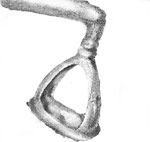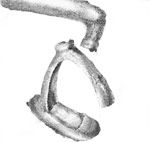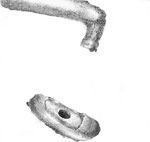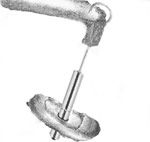What is Otosclerosis?
Otosclerosis is an abnormal, microscopic growth of bone in the walls of the inner ear which causes the stapes bone commonly called the “stirrup” to become frozen in placed or “fixed”. Normally the stapes, the smallest bone in the body, vibrates freely to allow the transmission of sound into the inner ear. When it becomes fixed to the surrounding bone, it prevents sound waves from reaching the inner ear fluids and hearing is impaired.
In a normal ear, sound (which consists of vibrations of air molecules) is funneled by the auricle, or “outer ear”, through the ear canal to the eardrum. Movements of the eardrum are transferred to the ossicles, the small bones of the middle ear. The eardrum and ossicles act as an amplifier and transducer, changing sound into a mechanical energy. At the end of this chain, the stapes vibrates in and out of the oval window, a thin membrane between the air-filled middle ear and fluid-filled inner ear. The vibration of the stapes sets up a wave of movement of the inner ear fluids. This, in turn, stimulates the fine sense organs (the hair cells) of the inner ear, which then stimulate the auditory (hearing) nerve, which carries the sound energy to the brain. It is this sequence of events that results in normal hearing.
HOW IS OTOSCLEROSIS TREATED?
No medication has proven to be effective in the treatment of ostosclerosis. Although a hearing aid can be worn successfully by most patients, natural hearing is preferred. Surgery has been found to be the most effective method of improving hearing loss caused by otosclerosis.
Surgical treatment has been available for about 45 years. The first operation for this disease was the fenestration procedure, which required mastoid surgery and an artificial opening in another part of the inner ear. The attention of the ear surgeons then became focused on the diseased stapes itself and the stapes mobilization procedure was developed. With the improvement in surgical technique, the treatment of choice then became the stapedectomy. This operation was first performed in 1956.
The stapedectomy operation involves the removal of the diseased bone and its replacement with an artificial substitute. Local or general anesthesia is used. The surgery usually takes place entirely through the ear canal so that no outer incisions are made.
The stapedectomy is done using an operating microscope. The surgeon will first fold forward approximately one-half of the eardrum so that he or she can reach the area where the stapes is located. The upper portion of the stapes is removed with fine instruments. There are several ways to properly manage the fixed footplate, depending upon the individual case. Most commonly, a small opening is made through the fixed plate with fine instruments, a micro drill, or laser. In some cases, the entire footplate may be removed. There are a variety of artificial stapes or “prostheses” that are available to replace this diseased bone. The most common prosthesis used, is a “piston” which attaches to the incus and inserts into the vestibule of the inner ear, thus bypassing the fixed stapes footplate.
|
The stapes bone (stirrup) is attached to the incus bone (anvil) by thin membranes and is separated. |
The stapes suprastructure is then “down-fractured” |
|
|
A laser and drill are used to make a small hole in the footplate. |
A prosthesis is placed over the incus and into the hole in the footplate. The surgeon then confirms that movement of the first middle ear bone, the manubruim (hammer), is transmitted through the incus and prosthesis into the hole and inner ear. Finally, the prosthesis is tightened around the incus to prevent sliding of the prosthesis away from the incus. |
CAN I HAVE THE OPERATION? WHAT ARE MY CHANCES OF SUCCESS?
An examination by an ear specialist, including a hearing test, is necessary to determine if you are a candidate for the operation. There are many different causes of deafness and not all patients with otosclerosis are candidates for stapedectomy.
The chances of obtaining a good result from this operation are about 90%. This means that 9 out of 10 patients will have improvement of hearing up to the level at which the inner ear is capable of functioning. If the inner ear functions normally, then nearly normal hearing can be restored. Patients with sensorineural hearing loss may require a hearing aid after surgery for optimal hearing. Approximately 7% of all patients have only partial recovery of hearing and 2% of all patients remain at the same level as before the surgery. The main risk is a 1% chance of developing inner ear hearing loss following the procedure due to factors that, as yet, are not entirely understood. For this reason, only one ear is operated on at a time and the worst ear is always done first.
WHAT SHOULD I KNOW BEFORE THE OPERATION?
Stapedectomy is usually performed on an outpatient basis. Your medical history, physical examination, a discussion about details of your surgical procedure and the associated risks and benefits will be addressed during the preoperative visit. At this time, you will be asked to provide your doctor with a list of the medications you are taking, including dosage and the frequency they are taken. You also will be asked to provide information about any known drug allergies. If you have symptoms of a cold one-week or less prior to the date scheduled for your operation, you should report that at once to your doctor.
WHAT CAN I EXPECT AFTER THE OPERATION?
The evening after the operation you should lie quietly on the unoperated ear. Do not be alarmed if you have some dizziness for the first few days after the operation. Following the stapedectomy procedure, most patients are able to go home that evening or the next morning.
At the time of surgery, a packing is placed in your ear canal. You will not notice a hearing improvement until this is removed one week after the surgery. At first, patients usually complain of a “hollow” sensation as though they were hearing from the bottom of a barrel or in a cave. Sounds may have an unattractive quality or may seem very loud, but they will gradually become normal. After the initial healing stage (4-6 weeks) your will notice an improvement in hearing. Hearing continues to improve for months.
Because a small taste nerve (the chorda tympani) runs through the ear, it is not unusual for the taste sensation to be altered for several weeks or months following the stapedectomy operation. Patients often report a metallic taste. Recovery of normal taste sensation usually occurs within a few weeks.
It is best not to blow your nose or sneeze for one week after surgery. You should keep water out of the ear for at least two weeks after the operation. When you shampoo or shower, place a cotton ball which has been lightly covered with petroleum jelly into the outer ear canal. Do not go swimming. Do not lift anything heavier than 20 pounds. Do not strain at bowel movements. You may be given a prescription for antibiotics to be taken orally. The eardrum will heal quickly. Two weeks following surgery, you may resume normal activities, including flying.
If, at any time after surgery, you should experience sudden hearing loss, pain, dizziness, or any new symptom related to the operated ear, you should notify the doctor immediately. Complications are very rare. However, early intervention may influence the final outcome.
Following your stapedectomy operation, it is important that you have periodic hearing tests. These tests provide your doctor with accurate information regarding the results of your surgery, the status of your unoperated ear, and the benefit of surgery should this ear also be affected by ostosclerosis.
WHAT ARE THE RISKS OF STAPEDECTOMY?
- DizzinessDizziness is normal for a few hours following stapedectomy and may result in nausea and vomiting. Some unsteadiness is common during the first few post-operative days; dizziness on sudden head movements may persist for several weeks. On rare occasions, dizziness is prolonged
- Taste DisturbanceTaste disturbance is not uncommon for a few weeks following surgery. In 5% of the patients this disturbance is prolonged.
- Loss of HearingIn about 2% of patients the hearing may be further impaired due to the development of scar tissue, infection, blood vessel spasm, irritation of the inner ear, or a leak of inner ear fluid (called a fistula). In 1% of patients, complications in the healing process may be so great that there is severe loss of hearing in the operated ear. This may be to the extent that one cannot obtain benefit from a hearing aid in that ear. For this reason the poorer hearing ear is selected for surgery.
- Ear Drum PerforationA perforation (hole) in the ear drum membrane is an unusual complication. It develops in less than 1% of patients and is usually due to an infection. Fortunately, should this complication occur, the membrane often heals spontaneously. If healing does not occur, surgical repair (myringoplastly) may be required.
- Weakness of the Face A very rare complication of stapedectomy is temporary weakness of the face. This may occur as a result of an abnormality or swelling of the facial nerve.
HEARING AIDS
If you are a suitable candidate for surgery, you are also likely to benefit from a properly fitted hearing aid. If you have otosclerosis and are not suitable for stapes surgery, you may still benefit from a properly fitted aid. Fortunately, patients with otosclerosis almost never become "totally deaf", but will almost always be able to hear with a hearing aid or with surgery plus an aid. The older the patient, the less the tendency for further hearing loss due to the hardening process of otosclerosis.





